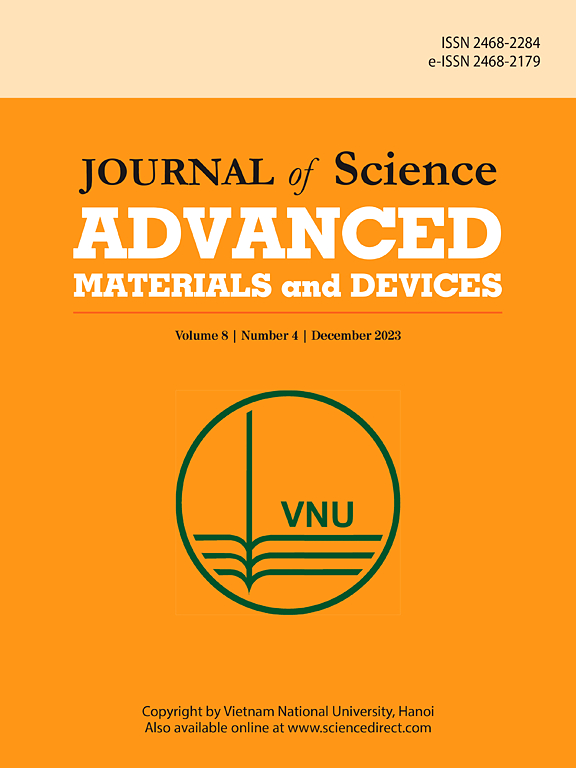Enhanced magnetic properties and densification of SrFe12O19/Fe3O4 hard/soft composites via cold sintering process
IF 6.8
3区 材料科学
Q1 MATERIALS SCIENCE, MULTIDISCIPLINARY
Journal of Science: Advanced Materials and Devices
Pub Date : 2025-05-06
DOI:10.1016/j.jsamd.2025.100900
引用次数: 0
Abstract
Magnetic ferrite composites are widely used in high-frequency applications due to their unique combination of magnetic and electrical properties. In this study, SrFe12O19/Fe3O4 (SFO/FO) hard/soft composite ceramics were synthesized using the cold sintering process (CSP) and characterized to evaluate their structural, magnetic and electrical performance. X-ray diffraction confirmed the coexistence of SFO and FO phases, while magnetic measurements revealed hybrid behavior combining hard and soft magnetic characteristics. The addition of FO phase improved particle dispersion and compaction, as reflected in the enhanced relative density (90–92 %) and Vicker hardness (3.0–3.7 GPa). Annealing changed the phase of Fe3O4 to α-Fe2O3 and reduced the pores, which made the composite materials more compact. These effects resulted in improved coercivity (∼4 kOe), remanence, and squareness ratio (∼0.5), with an optimized energy product (BHmax) of 0.80 MGOe observed for the 5 %FO composite. Electrical analysis showed an increase in AC conductivity with higher FO content, while annealing reduced conductivity to ∼10-7 S/cm at 1 kHz, ensuring sufficiently high impedance suitable for high-frequency applications. The successful synthesis of these composites via CSP at low temperatures demonstrates its feasibility as a method for investigating phase formation and magnetic interactions in ceramic nanocomposites.

冷烧结法增强SrFe12O19/Fe3O4硬/软复合材料的磁性能和致密性
磁性铁氧体复合材料由于其独特的磁性和电性能组合而广泛应用于高频应用。本研究采用冷烧结法(CSP)合成了SrFe12O19/Fe3O4 (SFO/FO)硬/软复合陶瓷,并对其结构、磁性和电学性能进行了表征。x射线衍射证实了SFO和FO相的共存,而磁性测量显示了硬磁和软磁特征的混合行为。FO相的加入改善了颗粒的分散性和压实性,体现在相对密度(90 - 92%)和维氏硬度(3.0-3.7 GPa)的提高上。退火使Fe3O4的相转变为α-Fe2O3,减少了孔隙,使复合材料更加致密。这些效应导致矫顽力(~ 4 kOe)、剩余物和方形比(~ 0.5)得到改善,5% FO复合材料的优化能积(BHmax)为0.80 MGOe。电学分析表明,高FO含量增加了交流电导率,而退火将电导率降低到1 kHz时的10-7 S/cm,确保了足够高的阻抗,适合高频应用。CSP在低温下成功合成了这些复合材料,证明了其作为研究陶瓷纳米复合材料中相形成和磁相互作用的方法的可行性。
本文章由计算机程序翻译,如有差异,请以英文原文为准。
求助全文
约1分钟内获得全文
求助全文
来源期刊

Journal of Science: Advanced Materials and Devices
Materials Science-Electronic, Optical and Magnetic Materials
CiteScore
11.90
自引率
2.50%
发文量
88
审稿时长
47 days
期刊介绍:
In 1985, the Journal of Science was founded as a platform for publishing national and international research papers across various disciplines, including natural sciences, technology, social sciences, and humanities. Over the years, the journal has experienced remarkable growth in terms of quality, size, and scope. Today, it encompasses a diverse range of publications dedicated to academic research.
Considering the rapid expansion of materials science, we are pleased to introduce the Journal of Science: Advanced Materials and Devices. This new addition to our journal series offers researchers an exciting opportunity to publish their work on all aspects of materials science and technology within the esteemed Journal of Science.
With this development, we aim to revolutionize the way research in materials science is expressed and organized, further strengthening our commitment to promoting outstanding research across various scientific and technological fields.
 求助内容:
求助内容: 应助结果提醒方式:
应助结果提醒方式:


